Anusha Narayanan and Avikal Somvanshi First Report
NATIONAL ANNOUNCEMENT OF SPARSHA 2008
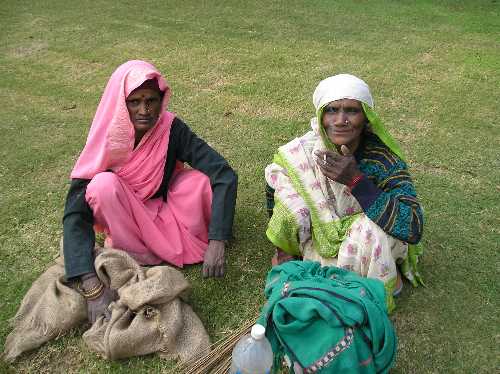 |
|
Rag-pickers outside of Humanyun's Tomb, New Delhi |
The present scenario of social service in our society is weak and most often goes unnoticed. We do live in a world which could really use a more humane approach to life, not just architecture.
As soon as our spring academic session ended, our work with the fellowship accelerated. We felt we were among those lucky few who had got to realize their one original idea on their own.
The reasonable frustrations started to float to the surface as we scratched our heads, not knowing where to go first: Take a step ahead into dealing with sponsors, announcements, the website and posters and so on for the contest? Or try to get through the framework of the academic structure and get a green flag for all our actions from the university?
An organized methodology evolved with our advisors, Ar. Arshia and Ar. Sumant, set us on the right track. They shared our experiences at each step and helped us get through the paperwork and the official documents that needed to be in place before we went our way about the practical scouting.
 |
|
Children of Laborours |
We knew we needed to do groundwork on the state of shelters and the condition of the homeless in India. Articles we collected from many distinguished media houses gave us a confirmation of reality.
Also the information provided by the Planning Commission Office (Gov. of India) and Kitab Mahal (Book House) New Delhi gave us the background on the N.G.O(s) working towards various social causes. In our quest we also went through the Indian Wasteland Development Policy (IWDP) and reports from HUDCO to grasp an idea of government initiatives.
Of course, this is not an extraordinary account. These are the crossroads we expected to meet because of our inexperience and lack of exposure in organizing events; also hurdles which we expected to cross over with a bit of confidence and a lot of help. And we did so as expected.
The experiences we set apart from the lot are those few personal encounters we had with the Indian homeless we so often wrote about in our essays and our proposal.
Opened in 2004, our university site is one where extensive construction work is constantly under-way. The smell of cement and the rattle of steel aren’t uncommon to us. We often have had field visits to all the under construction structures on campus at different stages of construction to have an insight into the insides of a building, the skeletal system as it is called.
So, naturally, almost alone on the campus when most of the faculty and students had left, Avikal spent a few
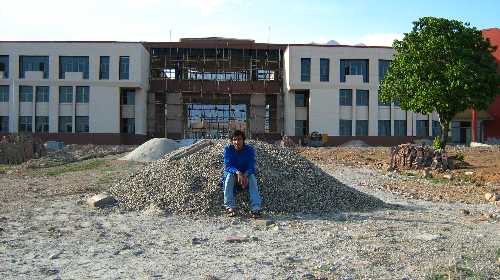 |
|
Ongoing construction project on S.M.V.D.U. campus |
days after the holidays, exploring the university campus. We now consider this worthwhile time, valuable for both of us.
He described to me how useful it had been searching through the abandoned labor shelters near a-now-completed site. These shelters were sustainable, ecological, and well insulated to heat and rain, and they had used discarded shuttering, bamboo and plastic wraps for construction, much like how a shelter for the homeless could be designed.
He also shared with me his outreach to the labourers. He said of how overwhelmed they were to see a student interact with them, unlike the rest, on a personal level. He was touched.
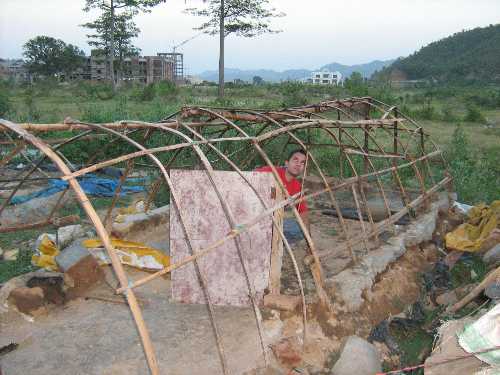 |
|
Labour-Shelters on campus, S.M.V.D.U. |
Did we really comprehend the magnitude of the problem we are dealing with? Are we really prepared to face this face of India? What if feeling the pain of these people was too harsh for us to withstand?
Perhaps we truly realized the sensitivity of the issue after Sparsha transformed from fiction to fact.
In New Delhi the sight of the homeless is as common as the sight of a cycle-rickshaw: At every nook and cranny; there are people sleeping on the subways; there are people on the foot-paths near Connought Place, the most popular market place of the Lutyen’s Delhi; people sleeping on the railway platform; on the bus stands after the bus-service stopped for the day; there were rag pickers that sat under the street light and ate near the gutters.
But, for me the saddest of all experiences was this: Just recently I was in a mall in uptown West Delhi, watching the blatant parade of luxury for the affluent and oblivion for the poor. I just came out of the mall and lovingly
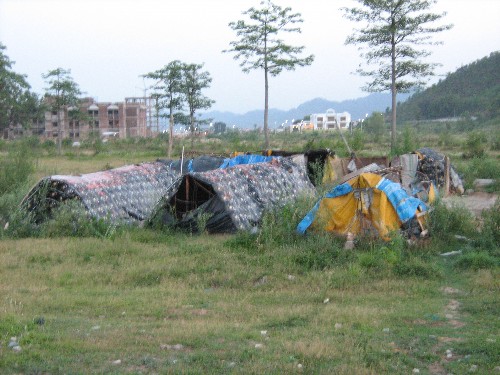 |
|
A cluster of labor shelters |
caressed a child, a beggar, on her head. She didn't even bother asking me for a penny, she just stood there, smiling and watched me until I vanished up the escalator to the nearest metro...
I was touched.
Even I had never realized how much just a touch can do, a touch of kindness.... and I find it funny, that the word ‘Sparsha’ (a Sanskrit word for touch) could just mean SO MANY THINGS.
I found that that kid begged more for kindness than for a penny...
We never know who waits with a smile in which corner of this beautiful country. OR what touches you so deeply, it moves your personality upside down!
What if all these attempts started to find a solution merely end up as archival notes to be preserved for the future. Wouldn’t it render Sparsha useless if it these were never implemented?
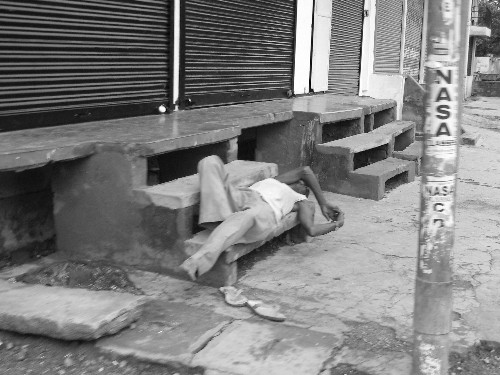 |
|
No other home for many a street dweller, Allahabad |
Trying to clear these doubts, we started looking for organization that could help us build these designs. The N.G.O.-Architecture For Humanity has been highly co-operative with us, and our project is now also featured on the Open Architecture Network, a platform for expression as well as an organization of reform, revolution, volunteering and restoration of sustenance in various communities across the globe.
We have been in consultation with Mr. Barb Alvarado, Associate Development Director of A.F.H. as well as Mr. Gautam Trivedi, the initiator of the New Delhi Chapter of A.F.H. They have been adding invaluable suggestions to our endeavor. We intend to get in touch with Centre for Science and Environment, C.S.E., New Delhi further.
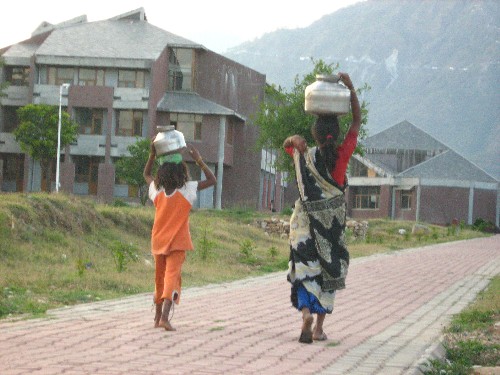 |
|
Construction workers, S.M.V.D.U Campus |
We hope we can help realize the ideas generated through the Process of Sparsha into something bigger than just competition entries. Perhaps a shelter built.
We have had the fortune of interacting with several esteemed academicians, architects and organizations with regards to the contest. Also the idea of Sparsha has impressed many a people who have written to us and commended the effort.
With the kind help and collaboration of our senior colleague from the discipline of B.Tech, Mr. Tarun Chawla, we have been able to establish a modest website by the name of www.sparsha2008.com. This website has now crossed over 10,000 hits within a week from its release showing its warm reception by the community.
With the help of our trusted friends in 2nd year B.Arch.(our class), and the moral boost given to us by our advisors
 |
|
A little girl playing near a construction site-- the cover photograph for Sparsha on the Open Architecture Network |
and the 1st year B.Arch. junior colleagues, we announced our contest officially open on the 7th of June 2008.
After hours of debate and quarrel it could have been a Herculean task for us had it not been for our sincere team. We shall also be releasing the posters for Sparsha: The Contest soon. We hope to receive an appreciable response as we await the entries.
We thank the BERKELEY PRIZE sincerely for this chance to conduct the contest. It is teaching us so much about life through first-hand experiences. Indeed we have started to Feel Again. And this feeling is one of deep and powerful realization which I hope to carry through into my way of life.
Words: Anusha Narayanan
Co-organizer, SPARSHA.
2008 Berkeley Prize Architecture Design Fellowship.
Photos: Avikal Somvanshi
Co-organizer, SPARSHA.
2008 Berkeley Prize Architecture Design Fellowship.
|







